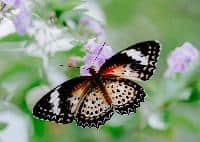Designating a section of your garden for native and heirloom flowers feeds our pollinators—and looks beautiful too
We’ve all heard that the butterfly population is at risk, so what can we do? Well, we can help out the monarchs—and other butterflies—by planting some specific flowers.
A “butterfly garden” landscape design is not only beneficial to the health of the butterfly population, but the blooming flowers provide colour and beauty while also increasing the productivity and health of vegetable gardens.
Why are butterfly gardens needed?
With the loss of important butterfly habitat due to growing urbanization, the increased use of pesticides and herbicides, as well as lost grasslands, we’re seeing an environmental threat to butterflies and other pollinators, like bees and birds.
A small plot of native perennials can serve as a permanent sanctuary or stopping ground (corridor) for butterflies to feed on, shelter and thrive. These garden areas can actually accommodate a variety of species at different stages of their life cycle: egg, larva, pupa and adult.
Creating and restoring butterfly habitats offsets what development, roadside mowing and wetland drainage have destroyed over the years.
Why are butterflies important to our environment and ecosystem?
Butterflies have a special, symbiotic relationship with our planet. Because they’re so sensitive to environmental changes, they serve as a warning for when something is off within an ecosystem. By studying butterflies, scientists are alerted sooner to the problems affecting living things, including humans.
Butterflies are a keystone species, which means many other species within an ecosystem rely on their health and the functions they provide. Butterflies are a tasty treat for other animals, and they pollinate the plants that birds, deer and other wildlife eat.
Also, while they’re pollinating and migrating, butterflies are transferring pollen from one plant to another. This promotes genetic variety and helps plants to become more resistant to disease, giving them a better chance at survival.
Finally, butterflies are essential in the agricultural crops that we as humans depend on. As they’re visiting your garden, they’ll repay you by pollinating plants that will feed you. They will also attract beneficial insects, like native bees and ladybugs, which will give you a healthy, pest-free garden.
A “butterfly” effect would impact our entire ecosystem, so the least we could do is plant them some flowers.
How and what to plant in your butterfly garden Photo by Xuan Nguyen on Unsplash
Photo by Xuan Nguyen on Unsplash
Location: Make sure to choose a sunny, low-wind spot in your yard. Butterflies rely on sunlight to regulate temperature, as well as for energy to forage and fly.
Implement a water source: A bird bath or small water dish will give butterflies a spot to land, rest and quench their thirst. If possible, partially submerge stones to provide perches for them. These landing pads are ideal warming spots for absorbing that sun. You can also throw some in sheltered and shaded areas for resting.
Mud puddling: Male butterflies sit on damp soil and extract the minerals necessary to their reproductive success. What you can do is sink a pan filled with a mixture of garden soil, sand and compost and keep it moist for them.
Shelter: It’s great to incorporate more than flowers in your garden, if you can. Trees and shrubs can provide shade, resting places and overwintering hibernation areas for butterflies, while also protecting against predators and harsh weather. It’s great to plant things that will come up all year, and not just in the spring/summer months.
Avoid pesticides: Sprays—even “organic” sprays, kill or harm butterflies. If it’s harming one thing, it’s harming them all. The best pest control for your garden is companion planting.
Mainly native plants: Though there are some non-natives that are great for butterflies, native plants are better adapted to your current climate, require fewer resources to be maintained, are hardier, and your local butterflies will be used to this particular flower.
What to plant to attract butterflies
- Milkweed
- Canadian Goldenrod
- Wild Bergamot
- New England Aster
- Black-eyed Susan
- Common Yarrow
- Marigolds
- Purple Coneflowers
- Salvias
- Echinacea
- Zinnias
- Butterfly bush
- Asters
- Fritillaries
- Joe-Pye weeds
- Boneset
- Dill
- Carrot
- Fennel
- Parsley

